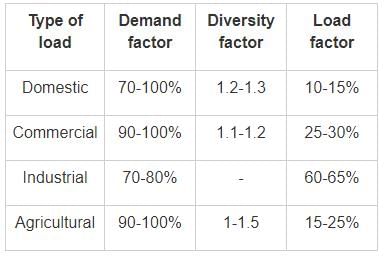Railways Exam > Railways Questions > The load factor for domestic loads may be tak...
Start Learning for Free
The load factor for domestic loads may be taken
- a)About 85%
- b)50-60%
- c)25-50%
- d)10-15%
Correct answer is option 'D'. Can you explain this answer?
Verified Answer
The load factor for domestic loads may be takena)About 85%b)50-60%c)25...

Most Upvoted Answer
The load factor for domestic loads may be takena)About 85%b)50-60%c)25...
The Load Factor for Domestic Loads:
The load factor refers to the percentage of available capacity that is being utilized in a particular system or operation. In the case of domestic loads, it represents the proportion of the total capacity of domestic loads that is being used. The correct answer for the load factor for domestic loads is option 'D', which corresponds to 10-15%.
Explanation:
The load factor for domestic loads can vary depending on various factors such as the time of day, season, and the overall demand for domestic transportation. In general, domestic loads tend to have a lower load factor compared to other types of loads due to the nature of domestic travel and the availability of alternative modes of transportation such as cars and buses.
Factors influencing the Load Factor for Domestic Loads:
1. Time of Day: The load factor for domestic loads is often higher during peak travel hours when people are commuting to and from work or school. During these times, the demand for domestic transportation is higher, resulting in a higher load factor.
2. Season: The load factor for domestic loads can vary depending on the season. For example, during holiday seasons or vacation periods, the load factor may be higher as more people travel domestically for leisure or to visit family and friends.
3. Demand for Domestic Transportation: The overall demand for domestic transportation can also influence the load factor. If there is a high demand for domestic travel due to events, conferences, or festivals in a particular region, the load factor may increase.
4. Availability of Alternative Modes of Transportation: Domestic loads may have a lower load factor compared to international loads due to the availability of alternative modes of transportation such as cars and buses. People may choose to drive or take a bus for shorter domestic trips, resulting in a lower load factor for domestic loads.
Conclusion:
In conclusion, the load factor for domestic loads is generally lower compared to other types of loads. The correct answer for the load factor for domestic loads is option 'D', which corresponds to 10-15%. This indicates that on average, only 10-15% of the total capacity of domestic loads is being utilized. However, it is important to note that the load factor can vary depending on various factors such as the time of day, season, and the overall demand for domestic transportation.
The load factor refers to the percentage of available capacity that is being utilized in a particular system or operation. In the case of domestic loads, it represents the proportion of the total capacity of domestic loads that is being used. The correct answer for the load factor for domestic loads is option 'D', which corresponds to 10-15%.
Explanation:
The load factor for domestic loads can vary depending on various factors such as the time of day, season, and the overall demand for domestic transportation. In general, domestic loads tend to have a lower load factor compared to other types of loads due to the nature of domestic travel and the availability of alternative modes of transportation such as cars and buses.
Factors influencing the Load Factor for Domestic Loads:
1. Time of Day: The load factor for domestic loads is often higher during peak travel hours when people are commuting to and from work or school. During these times, the demand for domestic transportation is higher, resulting in a higher load factor.
2. Season: The load factor for domestic loads can vary depending on the season. For example, during holiday seasons or vacation periods, the load factor may be higher as more people travel domestically for leisure or to visit family and friends.
3. Demand for Domestic Transportation: The overall demand for domestic transportation can also influence the load factor. If there is a high demand for domestic travel due to events, conferences, or festivals in a particular region, the load factor may increase.
4. Availability of Alternative Modes of Transportation: Domestic loads may have a lower load factor compared to international loads due to the availability of alternative modes of transportation such as cars and buses. People may choose to drive or take a bus for shorter domestic trips, resulting in a lower load factor for domestic loads.
Conclusion:
In conclusion, the load factor for domestic loads is generally lower compared to other types of loads. The correct answer for the load factor for domestic loads is option 'D', which corresponds to 10-15%. This indicates that on average, only 10-15% of the total capacity of domestic loads is being utilized. However, it is important to note that the load factor can vary depending on various factors such as the time of day, season, and the overall demand for domestic transportation.

|
Explore Courses for Railways exam
|

|
Similar Railways Doubts
The load factor for domestic loads may be takena)About 85%b)50-60%c)25-50%d)10-15%Correct answer is option 'D'. Can you explain this answer?
Question Description
The load factor for domestic loads may be takena)About 85%b)50-60%c)25-50%d)10-15%Correct answer is option 'D'. Can you explain this answer? for Railways 2025 is part of Railways preparation. The Question and answers have been prepared according to the Railways exam syllabus. Information about The load factor for domestic loads may be takena)About 85%b)50-60%c)25-50%d)10-15%Correct answer is option 'D'. Can you explain this answer? covers all topics & solutions for Railways 2025 Exam. Find important definitions, questions, meanings, examples, exercises and tests below for The load factor for domestic loads may be takena)About 85%b)50-60%c)25-50%d)10-15%Correct answer is option 'D'. Can you explain this answer?.
The load factor for domestic loads may be takena)About 85%b)50-60%c)25-50%d)10-15%Correct answer is option 'D'. Can you explain this answer? for Railways 2025 is part of Railways preparation. The Question and answers have been prepared according to the Railways exam syllabus. Information about The load factor for domestic loads may be takena)About 85%b)50-60%c)25-50%d)10-15%Correct answer is option 'D'. Can you explain this answer? covers all topics & solutions for Railways 2025 Exam. Find important definitions, questions, meanings, examples, exercises and tests below for The load factor for domestic loads may be takena)About 85%b)50-60%c)25-50%d)10-15%Correct answer is option 'D'. Can you explain this answer?.
Solutions for The load factor for domestic loads may be takena)About 85%b)50-60%c)25-50%d)10-15%Correct answer is option 'D'. Can you explain this answer? in English & in Hindi are available as part of our courses for Railways.
Download more important topics, notes, lectures and mock test series for Railways Exam by signing up for free.
Here you can find the meaning of The load factor for domestic loads may be takena)About 85%b)50-60%c)25-50%d)10-15%Correct answer is option 'D'. Can you explain this answer? defined & explained in the simplest way possible. Besides giving the explanation of
The load factor for domestic loads may be takena)About 85%b)50-60%c)25-50%d)10-15%Correct answer is option 'D'. Can you explain this answer?, a detailed solution for The load factor for domestic loads may be takena)About 85%b)50-60%c)25-50%d)10-15%Correct answer is option 'D'. Can you explain this answer? has been provided alongside types of The load factor for domestic loads may be takena)About 85%b)50-60%c)25-50%d)10-15%Correct answer is option 'D'. Can you explain this answer? theory, EduRev gives you an
ample number of questions to practice The load factor for domestic loads may be takena)About 85%b)50-60%c)25-50%d)10-15%Correct answer is option 'D'. Can you explain this answer? tests, examples and also practice Railways tests.

|
Explore Courses for Railways exam
|

|
Signup for Free!
Signup to see your scores go up within 7 days! Learn & Practice with 1000+ FREE Notes, Videos & Tests.
























